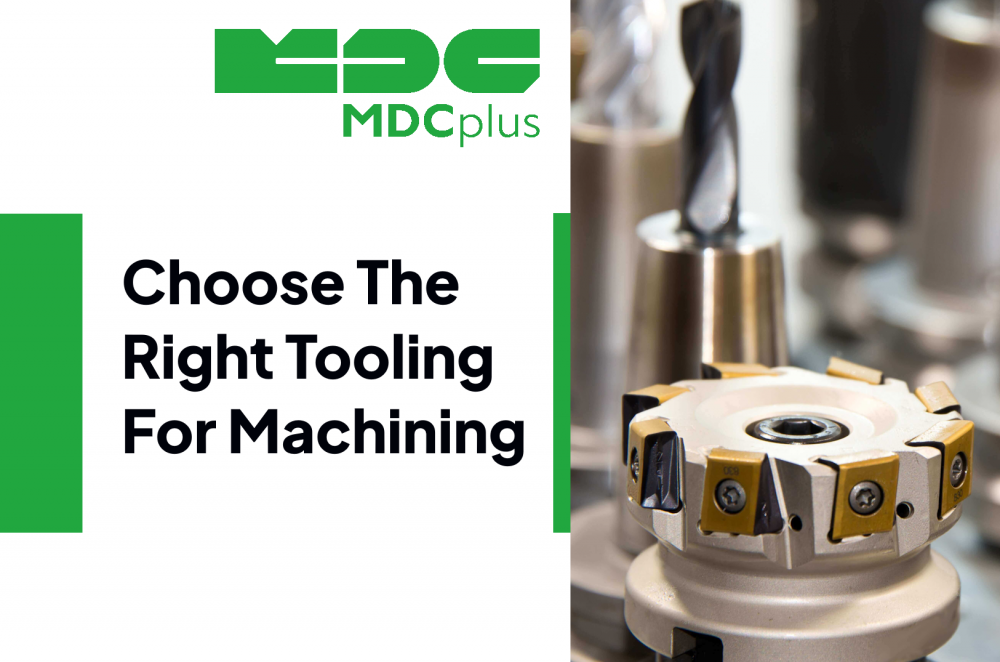No more manufacturing downtimes
Get started with your projectChoose The Right Tooling For Machining Your Materials
Choosing the wrong tooling for the material can silently bleed your profits and machine uptime. Tooling directly defines surface finish, cycle time, tool life, and scrap rate.
Material vs. Tooling: What’s the Right Match?
1. Aluminum Alloys
- Recommended Tooling: Uncoated or ZrN-coated carbide tools with high positive rake angles.
- Why: Aluminum is soft and sticky. It loads tools fast unless chip evacuation and sharp edges are managed.
- Caution: Avoid general-purpose tools—they clog fast. Use tools with polished flutes.
2. Stainless Steel (e.g., 304, 316)
- Recommended Tooling: TiAlN or AlTiN-coated carbide end mills.
- Why: High work hardening and poor thermal conductivity. Coated carbide handles heat and abrasion.
- Caution: Keep feeds up to avoid rubbing. Coolant delivery must be spot-on.
3. Mild and Carbon Steels
- Recommended Tooling: Standard HSS or uncoated carbide for mild steel; TiCN-coated for harder grades.
- Why: More forgiving. Tool selection is broader, though coating improves tool life.
- Caution: Too much speed burns the tool; find the right SFM zone.
4. Titanium Alloys
- Recommended Tooling: AlTiN-coated carbide with optimized geometries for chip thinning.
- Why: Low thermal conductivity and high strength = heat concentrates at the tool edge.
- Caution: Never let the tool dwell. Use high-pressure coolant.
5. Cast Iron
- Recommended Tooling: PVD-coated carbide or CBN inserts for hard grades.
- Why: Abrasive and brittle. Tools must resist wear, not deformation.
- Caution: Avoid coolant in gray iron - it causes thermal shock.
6. Plastics (e.g., Nylon, ABS, PEEK, Polycarbonate)
- Recommended Tooling: Uncoated carbide tools or high-speed steel with razor-sharp edges; often single-flute or O-flute geometry for chip control.
- Why: Plastics tend to melt or deform from heat. Sharp edges reduce heat generation and allow clean cuts.
- Caution: Too high spindle speeds generate heat and burrs. Avoid aggressive feed rates. Use air blasts instead of coolant unless the plastic tolerates fluids.
What Shops Still Get Wrong
-
Reusing general-purpose tools across materials
Many shops fall into the trap of keeping a "universal" set of tools for all jobs. The issue? Tool geometries and coatings are engineered for specific materials. Using the same end mill for both aluminum and stainless is not just lazy - it invites chatter, poor finish, and premature tool wear. -
Underestimating chip load differences
Chip load isn't a random number. It's a balancing act between feed rate, spindle speed, and tool diameter. Underfeeding causes rubbing and tool overheating. Overfeeding leads to tool breakage. Operators often misjudge chip loads, especially when switching between materials like plastics and hardened steels. -
Ignoring tool runout and clamping impact on fragile materials like aluminum or titanium
Runout kills precision. Even 0.01 mm of radial misalignment can destroy surface finish and cause uneven wear, especially in high-speed operations on soft or reactive metals. Poor workholding compounds the problem, introducing vibrations that can chip tools or ruin delicate parts.
How Digital Tool Management Transforms the Game
Traditional tooling decisions rely on tribal knowledge, assumptions, and static spreadsheets. That’s broken. Enter digital tool management systems like MDCplus—designed to turn every tool, setup, and wear event into actionable data.
What Changes:
- From Gut Feel to Data-Driven: Real-time tracking of tool usage, wear, and breakage gives a true cost-per-part view.
- From Isolated Incidents to Patterns: Identify recurring tooling failures by material, operator, or machine.
- From Chaos to Consistency: Centralized tool libraries eliminate guesswork and reduce setup variation.
- From Passive Monitoring to Predictive: Combine tool life data with sensor analytics to trigger replacements before failure.
Results You Can Expect:
- 25–30% increase in tool life with proper data-based adjustment
- 10–15% decrease in setup times through consistent tool pre-setting
- 20–30% reduction in emergency downtime due to unexpected tool breakage
Choosing the right tool for the right material is only half the battle. The real advantage comes from turning tool behavior into feedback loops. With a system like MDCplus, your tooling choices stop being a cost center—and start being a performance lever.
About MDCplus
Our key features are real-time machine monitoring for swift issue resolution, power consumption tracking to promote sustainability, computerized maintenance management to reduce downtime, and vibration diagnostics for predictive maintenance. MDCplus's solutions are tailored for diverse industries, including aerospace, automotive, precision machining, and heavy industry. By delivering actionable insights and fostering seamless integration, we empower manufacturers to boost Overall Equipment Effectiveness (OEE), reduce operational costs, and achieve sustainable growth along with future planning.
Ready to increase your OEE, get clearer vision of your shop floor, and predict sustainably?
